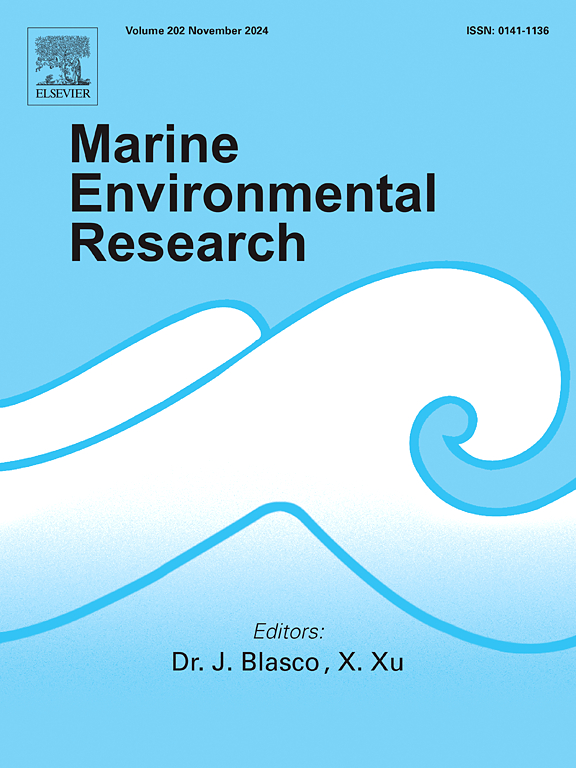沉积金属相的比较分析及其各自在形成底栖有孔虫生物群落中的作用:对环境生物监测的影响
IF 3
3区 环境科学与生态学
Q2 ENVIRONMENTAL SCIENCES
引用次数: 0
摘要
本研究通过沉积物全消化(TD)和沉积物三相(即水、有机物和氢氧化锰)的顺序化学萃取,研究了潜在有毒元素(PTEs)浓度对巴西里约热内卢州(东南部)最大的过渡生态系统之一--瓜纳巴拉湾(GB)中底栖有孔虫的影响。研究还考虑了有机物的数量和质量、流体力学和物理化学参数的变化,将其作为这些生物的压力参数。统计分析提供了令人信服的证据,证明通过消化沉积物总量来测量 PTEs.TD 并不是评估污染对底栖有孔虫等小型底栖生物影响的最有效方法。相反,它记录了底栖有孔虫对沉积物中可获得(或软结合)的 PTE 浓度梯度、有机物质的数量和质量、环境封闭程度以及物理化学变量变化的反应。因此,这项工作证明了分析可用金属和/或软结合金属组分对于了解生物体对环境影响的反应的重要性。本研究结果对环境生物监测研究和基于有孔虫的生态指数的开发具有重要意义。本文章由计算机程序翻译,如有差异,请以英文原文为准。
Comparative analysis of sedimentary metal phases and their respective roles in shaping living benthic foraminiferal communities: Implications for environmental biomonitoring
This work examines the effects of the potentially toxic element (PTEs) concentrations through total sediment digestion (TD) and sequential chemical extraction in three sedimentary phases (i.e., water, organic matter, and manganese hydroxides) on living benthic foraminifera in the Guanabara Bay (GB), one of the largest transitional ecosystems in Rio de Janeiro State (SE Brazil). It also considers the variations in the quantity and quality of organic matter, hydrodynamics and physicochemical parameters as stressors parameters for these organisms. The statistical analysis provides compelling evidence that measuring PTEs.TD through the total digestion of sediments is not the most effective method for assessing the impact of pollution on living meiofaunal organisms like benthic foraminifera. Conversely, it documents that benthic foraminifera respond to gradients of available (or soft-bound) PTE concentrations in the sediment, quantity and quality of organic matter, the level of environmental confinement, and changes in physicochemical variables. Therefore, this work supports the importance of analyzing available and/or softbound metal fractions for disentangling the response of living organisms to environmental impact. The present findings have significant implications for environmental biomonitoring studies and the development of ecological indices based on foraminifera.
求助全文
通过发布文献求助,成功后即可免费获取论文全文。
去求助
来源期刊

Marine environmental research
环境科学-毒理学
CiteScore
5.90
自引率
3.00%
发文量
217
审稿时长
46 days
期刊介绍:
Marine Environmental Research publishes original research papers on chemical, physical, and biological interactions in the oceans and coastal waters. The journal serves as a forum for new information on biology, chemistry, and toxicology and syntheses that advance understanding of marine environmental processes.
Submission of multidisciplinary studies is encouraged. Studies that utilize experimental approaches to clarify the roles of anthropogenic and natural causes of changes in marine ecosystems are especially welcome, as are those studies that represent new developments of a theoretical or conceptual aspect of marine science. All papers published in this journal are reviewed by qualified peers prior to acceptance and publication. Examples of topics considered to be appropriate for the journal include, but are not limited to, the following:
– The extent, persistence, and consequences of change and the recovery from such change in natural marine systems
– The biochemical, physiological, and ecological consequences of contaminants to marine organisms and ecosystems
– The biogeochemistry of naturally occurring and anthropogenic substances
– Models that describe and predict the above processes
– Monitoring studies, to the extent that their results provide new information on functional processes
– Methodological papers describing improved quantitative techniques for the marine sciences.
 求助内容:
求助内容: 应助结果提醒方式:
应助结果提醒方式:


